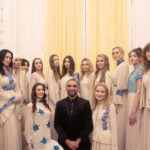Part 2 – Construction the Finer Detail
Thanks for staying with me as we explore this area of expertise in more detail. In the previous article, I shared with you the history of the craft. I would now like to share with you some of the detail behind the seams.
In high-end stores and boutiques, premium priced garments should be made to a high standard in terms of quality of fabric, and overall finish, alongside design. The majority of the work carried out to make designer ready-to-wear garments are through the usage of an industrial sewing machine.
With Haute Couture, whilst the sewing machine is also used, there are other factors taken into consideration; the designer’s vision for the garment, its structure and construction, may require layers of fabric in place that acts as a support to assist in moulding the fabric to a desired result. Think of a voluminous dress that stands away from the body, in the past a structured frame or hoop would be made to support the fabric, nowadays that would be layer upon layer of fabric.
It’s a labour intensive process, there is a lot of hand-sewing in Couture and Haute Couture garments, from supporting the structure of a seam, to the inside finish; what presents itself as a minor detail is in fact a major detail as it is all part of the construction.
A client garment will be subjected to this process, the inner structures may be to assist in the symmetry of design for the silhouette of the client’s body; this fit and construction goes back to my previous conversation as to the discerning eye. The fitter is always looking for balance, complementing the client’s silhouette.
Fabrics are also expensive alongside their supportive counterparts, plus the meterage required; a wool tweed fabric for example because of its weave could be supported with silk organza, a crisp fabric that again would need to be hand-sewn in place. Another layer of fabric may be a consideration, and then there is the fitting of the garment in the main fabric.
In the meantime pressers who know how to press and handle the garment – another required skill, pressing is not the same as ironing!
Hand-embroiders can also be called upon, hundreds of hours can be required for elaborate detailing, think of wedding dresses with hand embroidery or handmade silk flowers.
Bearing in mind we have already discussed the necessary fittings in calico for the toile (the prototype garment). Fittings in the main fabric are also required, again adjustments may have to be made, the garment dismantled and reconstructed to be fitted again, until correct.
One Haute Couture garment may pass through many hands, as you start to delve deeper into the process of Haute Couture, the workmanship that goes into producing one garment for a client, suddenly the expense incurred has a different meaning. In today’s fast fashion I feel we are missing out, there are vintage Couture dresses dating back to 50 years plus, that are being worn on the red carpet today, and highly sought after, a timeless quality, a beauty to behold, which is why they are also called investment pieces.

Coral Turner is a couture designer based in London. Specialising in unique ready-to-wear Race Day Fashion, her emphasis is focused on the way clothes make you feel. In addition a dressmaking service is also available. “My dresses are just like you… one of a kind.” See her website at https://coralturner.com








